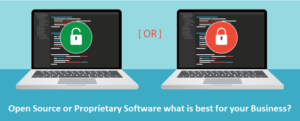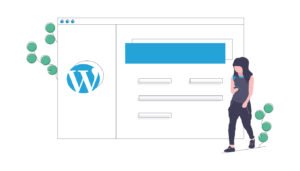
How to decide if open source or proprietary software solutions are best for your business
Blog Modified: 24 August,2021
Is Open Source or Enterprise Solutions best for you business? We’ve been asked countless times by our prospective customers before they venture into product development. It might seem like a brilliant idea to have proprietary software for your business, to keep it as an original and an intellectual property of the business enterprise. This way the source code will be protected, with only the intellectual property owner having the rights to edit or modify the code. Often, the businesses have two options: Make their software solutions open source or proprietary.
Difference between open source and proprietary
Before choosing to go open source or proprietary, it is important to understand the basic differences between the two.
| Open Source | Proprietary |
| When a software is licensed as open source, developers have access to the source code, and they can see and edit the code as per their requirement. The most famous example of such a software is WordPress, anyone can use the original version, or make changes to the original and share the modified ones. | When a software is licensed as proprietary, then the organization has full rights to the source code. The users would be people who purchase this software, and they employ the software as it is built, with no changes whatsoever. Most of the corporations rely on proprietary software. |
How does the open source software system work?
The copyright for the open source software belongs to the author, and there will be a vendor who acts as a distributor for the software. The software will be licensed like OpenFOAM for CAE, a variety of software licenses will be available, within a particular license agreement. There are some rules and criteria set for the open source software that the developers and organizations must comply with.
What are the two types of open source software?
Project or community open source – The source code is developed by a community of developers who work in collaboration with each other to improve the codes and support each other. The developers may not get any remuneration for their work as it is mostly free, and the projects may be copyrighted by them, especially for large projects like Linux and Apache Web Server.
Commercial Open Source Software or COSS – In COSS, the full copyright, patents and trademarks are managed by one organization. The contributor would have to transfer the code’s copyright to this entity, either freely or for a fee. Red Hat is the biggest COSS company and Facebook is the biggest COSS code contributor.
Deciding What Software is Right For You.
Before deciding which kind of software is right for your business needs, it would be wise to analyze the pros and cons of both:
Advantages of Open Source
1. Cost effectiveness
Obviously, the most noted advantage of open source software is that it frees up resources for the organization to invest in other important aspects of business, namely, faster storage arrays, cloud storage, high speed networks and so on.
2. Try for free before purchase
With COSS or Community Open Source, anyone can download the software for free, with its source code. COSS often offer a free version of their software package, complete with the source code.
3. Detailed documentation and support
With Community open source, there is an incredible community of users and developers who are ready to help. And there is detailed documentation as well, in plenty of forums, newsgroups, live chat and support, email lists and so on.
4. Quick fixes on the bugs
There will be thousands of eyes on the open software, which means if there is a bug, it will be instantly noticed and rectified. With proprietary software, there will be a smaller development staff, and so the fixes take time. For open source, the users have the source code, so they can make the fixes instantly.
5. Open standards around communication protocols
Interoperability becomes very easy with open source communities because they are open standards around data formats and communication protocols. The high level interoperability easily happens between business applications and customer applications too.
6. No worries of vendor abandonment
With open source, you will never be left holding the bag because there is always scope for continued improvements, maintenance and support. The community is always so wide, diverse and distributed, so there is no reliance on a single vendor.
7. Excellent security
Open source software is actually secure, because whenever security holes happen, it will be instantly fixed by the huge community, so someone will always be there on the lookout.
8. It is open source
Of course, the source code is open source, which means anyone who can create a code can study, analyze and modify the codes to perfect and better them. More functionalities can be added and security holes plugged.
So, why isn’t people choosing open source software?
The benefits far outweigh the disadvantages posed by open source software, but some people complain that the software interface is comparatively less user-friendly, and only a person with extensive coding experience can essentially use the software. And the documentation part is also a bit disadvantageous. Yes, there is a lot of documentation, but it often is poorly done, and outdated.
The advertising components can be a bit annoying in the open source software.
Benefits of Proprietary Software
There are plenty of advantages to choosing proprietary software. Let’s go through some of them:
1. Only a Single Vendor
Normally, with paid software solutions, there will be only one vendor with all the tools in its package. Open source is more like the la carte approach.
2. Integration across multiple platforms
A feature that definitely aces all the other features of proprietary solutions. The integration feature adds on to the usability and convenience of the software, for example, if a user is working with Microsoft’s Lync instant messaging app, the app would be hooked onto Microsoft Outlook, so the person can see the availability status of other contacts, email or message them.
3. Delivers enterprise grade products
Proprietary software are often enterprise grade products because they are tailored to meet the demands, hence come with a plethora of features.
4. No great developers needed
Since with proprietary software you don’t need to customize or add more codes to the software, there is no need to hire an expert developer team to tweak the codes.
The Major Disadvantages of Choosing Proprietary Software
It might appear that proprietary software could be more secure than open source because the source code is not easily available. Unfortunately, that’s not the case, mainly because there are only smaller teams who continuously work on the proprietary projects, and there is every chance of missing out on bugs and mistakes in the code.
1. Chances of Vendor lock-in
If a vendor closes up shop and abandons the project, then things could get risky. You could end up holding an orphaned project, with no improvements or follow up support.
2. Security could be tricky
The security of the proprietary software depends a lot on the security of the source code. The possibility of backdoor Trojans, and the threat of other bugs and obstacles are higher. When enterprises are spending hefty amounts of security and hacking technologies.
In spite of embracing new security patches and applying countermeasures like antivirus programs to meet the threat of hacks, attacks and viruses headlong, there have been serious issues that damaged vital electronic data and shut down businesses or threatened their very foundation.
3. Flexibility is grossly limited
Proprietary software solutions are developed for a specific need, industry and users, so they might not be suitable for all requirements. There wouldn’t be many customized options since the users are not building the software to go with customized options.
4. Portability is not as expected
It is not easy to extract data and files out of a system with a proprietary solution and integrate it with other systems because there is no option for it.
You might argue that open source is a magnet for hackers because anyone can view the code, and malicious hackers can easily explore the vulnerabilities. But that’s just a myth because open source codes encourages collaboration unlike proprietary software which is maintained and managed by a single company.
There are thousands of contributors all over the world who are ready to create something new every time, and improve upon what’s already there. So if there are security loopholes, those will be closed, and for free.
Conclusion
The debate about whether to choose open source and proprietary software is credible and will be there forever. Both choices have their own advantages and disadvantages, so a careful analysis will shed more light on what you need to make. The decision about which one to choose will depend on what your enterprise’s long term data integration goals are. You need to consider a couple of things before you make the final choice:
The cost of proprietary software can be a put off at first, but you get total ownership of the software which would be a good thing in the long run, if you have a team of developers to manage it
There is commercial open source software that comes with a certain cost, and that could be bigger than initial proprietary software solutions.
Talk to Our Team for Expert Opinion.
Scalan Labs is a full-service product engineering company that provides dedicated teams for full stack development. We have the top1% talent for product engineering and dedicated teams to help you reach your business goals. Contact us today to learn more about how we can help you!





